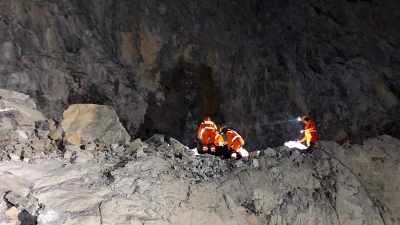This midcap compounder is once again making a big business bet. Another 10x return opportunity?
Between 2018 and 2021, Deepak Nitrite’s stock delivered staggering returns: revenue jumped from Rs 1,700 crore in FY18 to over Rs 8,000 crore by FY23, and EBITDA soared from Rs 198 crore to over Rs 1,500 crore. But that momentum has slowed. The stock has fallen in the last three years. The company is now gearing up for its next act: moving toward value-added polymers and specialty solvents. This pivot could make Deepak Nitrite a global player in performance materials. But can it replicate its past success?
 Deepak Nitrite is gearing up for its next act, a Rs 14,000 crore capex cycle aimed at moving from bulk chemicals to value-added polymers and specialty solvents. (www.godeepak/mediakit)
Deepak Nitrite is gearing up for its next act, a Rs 14,000 crore capex cycle aimed at moving from bulk chemicals to value-added polymers and specialty solvents. (www.godeepak/mediakit)Between 2018 and 2021, Deepak Nitrite’s stock surged nearly 10x. The reason? A single, perfectly timed bet: setting up India’s first large-scale phenol and acetone plant. At the time, India was importing 100% of its phenol requirements. Deepak Nitrite’s plant changed that overnight.
The company’s revenue jumped from Rs 1,700 crore in FY18 to over Rs 8,000 crore by FY23. Earnings before interest, tax, depreciation and amortization (EBITDA) soared from Rs 198 crore to over Rs 1,500 crore, operating margins expanded to 28-30%, and return ratios touched 35-40%.
For a chemical company, it was a dream execution.
But that momentum has slowed.
The stock has fallen in the last three years, underperforming its peers and the broader market. Revenues dipped slightly in FY24 to Rs 7,682 crore, net profit softened to Rs 11 crore, and margins compressed under the pressure of cheaper Chinese imports and input cost volatility.
Deepak Nitrite is gearing up for its next act, a Rs 14,000 crore capex cycle aimed at moving from bulk chemicals to value-added polymers and specialty solvents. The centerpiece? A fully integrated phenol-to-polycarbonate manufacturing chain, a first for India.
This pivot could make Deepak Nitrite a global player in performance materials. But can it replicate its past success in a more complex, more competitive landscape?
 Figure 1: Stock price movement of Deepak Nitrite Ltd. (Source: Screener.in)
Figure 1: Stock price movement of Deepak Nitrite Ltd. (Source: Screener.in)
Inside Deepak Nitrite’s business
To understand where Deepak Nitrite is headed, it’s important to first understand what it already is.
A two-engine business model
At the heart of Deepak Nitrite’s operations are two core business segments: Advanced Intermediates and Phenolics.
The Advanced Intermediates division is where the company built its early foundation. It supplies over a hundred chemical compounds that go into everything, from dyes and pigments to agrochemicals and pharmaceuticals. These are not headline-grabbing products, but they are critical to multiple industries.
The business is broad-based and diversified, though it’s also exposed to price cycles and pressure from low-cost Chinese competition. In FY24, this division contributed just under a third of the company’s consolidated revenue.
 Figure 2: Business of Advanced Intermediates Part 1 (Source: AR FY24, Quarterly Report Dec 24)
Figure 2: Business of Advanced Intermediates Part 1 (Source: AR FY24, Quarterly Report Dec 24)
 Figure 2: Business of Advanced Intermediates Part 2 (Source: AR FY24, Quarterly Report Dec 24)
Figure 2: Business of Advanced Intermediates Part 2 (Source: AR FY24, Quarterly Report Dec 24)
The other, and more recent engine, is the Phenolics segment.
This was the game-changer. In 2018, Deepak Nitrite commissioned India’s first phenol and acetone plant in Dahej, Gujarat. Until then, India imported all its phenol and acetone, making it a Rs 3,000+ crore import business. Deepak Nitrite captured over 60% market share in both products within just a few quarters. Revenue exploded. Margins expanded. Between FY18 and FY23, the company’s topline more than doubled, with phenolics accounting for nearly 70% of revenue by FY24.
 Figure 3: Business of Phenolics Part 1 (Source: AR FY24, Quarterly Report Dec 24)
Figure 3: Business of Phenolics Part 1 (Source: AR FY24, Quarterly Report Dec 24)
 Figure 3: Business of Phenolics Part 2 (Source: AR FY24, Quarterly Report Dec 24)
Figure 3: Business of Phenolics Part 2 (Source: AR FY24, Quarterly Report Dec 24)
From intermediates to integration
But Deepak Nitrite isn’t just selling phenol and acetone anymore. It’s now going deeper into the value chain, converting these base chemicals into downstream solvents like IPA, MIBK, and MIBC, products that fetch higher prices and offer better margins. It’s also moving forward into specialty materials like Bisphenol-A (BPA) and, eventually, polycarbonate (PC), an engineering plastic used in electronics, automotive parts, and consumer goods.
This move toward vertical integration is crucial.
By owning every step of the production journey from raw materials like benzene and propylene, to solvents, resins, and polymers, Deepak Nitrite reduces its dependency on volatile input markets and improves control over pricing. That’s a massive advantage in an industry where margins often depend on your ability to manage costs better than the competition.
The company is also taking control of supply risk. For example, it’s building a new nitric acid plant to reduce exposure to a raw material that saw 3x price inflation during the supply crunch of FY22. Similar backward integration steps are being taken in hydrogenation and fluorination, specialty chemistries that will allow it to serve higher-end pharma and agrochemical clients.
A national play with global implications
While Deepak Nitrite’s footprint is firmly rooted in India, its importance goes beyond domestic manufacturing. It represents a broader shift in India’s industrial policy toward self-reliance in critical inputs.
India’s chemical import bill still runs into tens of billions of dollars. Polycarbonate,
for instance, is a Rs 6,000 crore market, and 100% of it is imported. Solvents like MIBK and acetophenone are in the same boat. Deepak Nitrite’s entry into these segments through focused capex not only helps reduce India’s import dependency but also positions it as a global player in high-barrier, high-value products.
At the same time, its export potential is growing, especially as Western clients seek to diversify their supplier base. With an upcoming R&D centre and a sharper focus on application-specific chemistries, Deepak Nitrite is starting to transition from a “bulk supplier” to a custom solutions provider, a move that could unlock long-term, sticky contracts with global customers.
From chemicals to materials science
Put simply, Deepak Nitrite is no longer just a chemical manufacturer. It’s building an integrated platform that spans from commodity inputs to advanced materials. That matters for three reasons.
First, it creates pricing power – higher up the value chain, fewer players exist and switching costs for clients rise.
Second, it insulates margins – integrated players can withstand commodity price shocks far better.
Third, it gives Deepak Nitrite’s optionality, whether the future lies in engineering plastics, specialty solvents, or custom intermediates, the company has positioned itself to pivot quickly.
So while its legacy business may continue to deal with cyclical pressures, the strategic bets being made today, particularly in downstream integration and product innovation, could define the next decade of its growth.
Import substitution: Deepak Nitrite’s next big bet
India’s dependence on imported chemicals is more than just a trade statistic, it’s a structural gap. From phenol and acetone to polycarbonate and solvents, the country has long relied on overseas suppliers while domestic players lagged behind.
Deepak Nitrite has been one of the few companies to consistently turn this gap into opportunity.
In 2018, it disrupted a Rs 3,000 crore phenol-acetone import market by setting up India’s first large-scale plant at Dahej. That single move reshaped its earnings trajectory. Now, Deepak Nitrite is attempting to do it again on a much larger scale.
From phenol to polycarbonate
The company is investing over Rs 14,000 crore across a suite of projects, led by a 165,000-tonne polycarbonate facility, India’s first. Polycarbonate is used in autos, electronics, and appliances, yet India currently imports 100% of its Rs 6,000 crore demand.
Deepak Nitrite isn’t just entering this space, it’s building a fully integrated value chain: from benzene and propylene, into phenol, acetone, and BPA, and finally, into polycarbonate resin and custom compounds. This level of backward and forward integration is rare globally and unprecedented in India.
 Figure 4: Management on Business of Polycarbonates. (Source: Quarterly Report Dec 24)
Figure 4: Management on Business of Polycarbonates. (Source: Quarterly Report Dec 24)
Why it matters
For India, it reduces import dependence on a critical material. For Deepak Nitrite, it means better margins, deeper control, and a ticket into high-value, export-ready sectors. With global majors seeking alternatives to China, Deepak Nitrite, backed by Trinseo’s technology could emerge as a reliable supplier to global OEMs.
But the pipeline goes beyond polycarbonate. Projects in MIBK/MIBC, acetophenone, nitric acid, and fluorochemicals are all part of the same strategic intent: move downstream, replace imports, and capture higher value.
High stakes, higher ambition
Of course, there are risks such as execution challenges, cost overruns, and global price volatility. But this isn’t a policy-driven bet. It’s economic logic. If Deepak Nitrite can produce at competitive costs with full integration, it doesn’t just protect its turf, it becomes a long-term enabler of India’s manufacturing push.
And if that plays out, the company won’t just be supplying chemicals, it’ll be building the backbone of India’s industrial future.
Post-COVID performance: Growth, volatility, and the next phase
Between FY18 and FY22, Deepak Nitrite hit a dream run. Revenues surged from Rs 1,700 crore to Rs 6,800 crore, powered by the ramp-up of its phenol plant and favorable pricing across the chemical sector. Net profit grew sixfold, crossing Rs 1,000 crore. But since then, the picture has become more nuanced.
Revenue: Growth slows, foundations strengthen
In FY23, the company was hovering around Rs 8,000 crore in revenue, up 17% YoY. But in FY24, sales dipped 3.3% to Rs 7,682 crore. This wasn’t due to lower volumes as phenol and acetone output hit record highs but rather, price normalisation and weakness in the agrochemicals-linked intermediate segment.
The topline remains sensitive to commodity cycles, but the company is gradually shifting toward value-added products. With new downstream capacities slated to launch between FY25 and FY29, this period of softer growth may just be a breather before the next phase.
Margins: Compression now, recovery ahead
Margins have come off their pandemic era highs. In FY20, operating profit margin peaked at 28.5% and ROE crossed 36%. But by FY24, net profit had softened to Rs 811 crore, with operating margins dropping to 10.5%, and EBITDA margin declined from ~48% in FY21 to just over 30%.
Key reasons: input cost inflation for coal, nitric acid, toluene and a soft demand environment that limited pricing power.
Still, management sees this as cyclical. With backward integration (e.g., nitric acid) and high-margin downstream products like MIBK and fluorochemicals coming online, margins are expected to inch back toward 24-25% by FY27–28.
Segment view: Phenolics steady, intermediates recovering
The Phenolics segment led the charge in FY24, contributing nearly 70% of total revenue. Even with lower prices, volumes were strong with over 100,000 tonnes sold in Q4 alone and high utilisation supported operating leverage.
The Advanced Intermediates segment struggled, hit by weak demand in agro and dyes, plus dumping of cheap Chinese alternatives. EBIT margins slipped to single digits in some quarters. However, a turnaround is likely by FY25-26, with new fluorinated/nitrated capacities and a ramp-up in exports and custom contracts.
Balance sheet: Clean today, leveraged tomorrow
Deepak Nitrite’s financial discipline stands out.
As of FY24, it was net debt free, holding Rs 800+ crore in cash, and maintaining healthy cash flows. But with Rs 14,000 crore in capex planned, debt will rise. The company is approaching this with caution, phasing investments, leaning on internal accruals, and leaving room for equity infusion if needed.
The verdict
Post-COVID, Deepak Nitrite has retained scale and leadership but faced pressure on pricing and profitability. Yet beneath the surface, it’s repositioning for long-term value.
The next few quarters may reflect consolidation. But if execution stays on track, the years ahead could look like controlled, margin-rich acceleration — a very different earnings curve from the last cycle.
Valuation: High expectations, but patience too
Deepak Nitrite sits at an unusual intersection, it’s neither a pure commodity player nor a high-margin niche specialist. Instead, it’s a mid-cap compounder transitioning into value-added materials. And the market is valuing it accordingly.
A premium but justified (so far)
As of April 2025, the stock trades at ~36x FY24 earnings, costlier than commodity peers, but cheaper than top-tier specialty players. Vinati trades at ~40x, SRF and Navin Fluorine at ~78x.
Despite decline over the past 3 years, Deepak Nitrite’s multiple hasn’t derated. That’s because while near-term earnings are flattish, the Rs 14,000 crore capex cycle has created a long runway investors are still willing to back.
Capital efficiency holds the key
On an EV/EBITDA basis, Deepak Nitrite currently trades at 18-20x trailing EBITDA, which is below other peers’ 10-year median of ~30x. This metric is useful in comparing operating performance across companies, regardless of how they are financed.
 Figure 5: Valuation Metrics Peer Comparison. (Source: Tijori Finance)
Figure 5: Valuation Metrics Peer Comparison. (Source: Tijori Finance)
 Figure 5: Valuation Metrics Peer Comparison. (Source: Tijori Finance)
Figure 5: Valuation Metrics Peer Comparison. (Source: Tijori Finance)
Unlike many specialty chemical companies that enjoy premium multiples, Deepak’s current valuation reflects investor caution. The muted stock performance over the past three years suggests that the market is waiting for clearer signs of execution before rerating the stock.
However, the underlying capital efficiency remains strong. Deepak has delivered a consistent ROE (Return on Equity) of 16-18% and ROCE (Return on Capital Employed) of 15-16%, even during industry downcycles. For perspective, the company’s 10-year median ROCE is around 20%, ahead of peers.
 Figure 6: Return Ratio Comparison across Peers. (Source: Tijori Finance)
Figure 6: Return Ratio Comparison across Peers. (Source: Tijori Finance)
With downstream products like polycarbonate, MIBK/MIBC, and fluorochemicals expected to go commercial between FY25 and FY29, analysts expect ROCE to climb back toward 20-22%, strengthening the argument for a re-rating if execution stays on track.
What’s priced in and what isn’t
The current valuation reflects belief in Deepak Nitrite’s transformation into a more integrated, margin-stable business. But some upside drivers are yet to be fully baked in:
Polycarbonate won’t generate revenue until FY29.
New downstream products like MIBK, BPA, and fluorochemicals are still in the ramp-up phase.
The R&D push could open up pharma and electronics exposure, but that’s still early days.
What could drive the next rerating? Faster execution, a margin rebound, or export wins. What could hold it back? Project delays or prolonged Chinese pricing pressure.
The market’s message
Deepak Nitrite is no longer trading on past performance. It’s being valued for the future it’s building. The market is saying: “We believe in your plan. Now show us the results.”
It’s a valuation based on conviction, temperament, patience, and waiting for the next inflection point.
Note: This article relies on annual and industry reports data. We have used our assumptions for forecasting.
Parth Parikh has over a decade of experience in finance and research and currently heads the growth and content vertical at Finsire. He has a keen interest in Indian and global stocks and holds an FRM Charter along with an MBA in Finance from Narsee Monjee Institute of Management Studies. Previously, he held research positions at various companies.
Disclosure: The writer and his dependents do not hold the stocks discussed in this article.
The website managers, its employee(s), and contributors/writers/authors of articles have or may have an outstanding buy or sell position or holding in the securities, options on securities or other related investments of issuers and/or companies discussed therein. The content of the articles and the interpretation of data are solely the personal views of the contributors/ writers/authors. Investors must make their own investment decisions based on their specific objectives, resources and only after consulting such independent advisors as may be necessary.






- 01
- 02
- 03
- 04
- 05

























